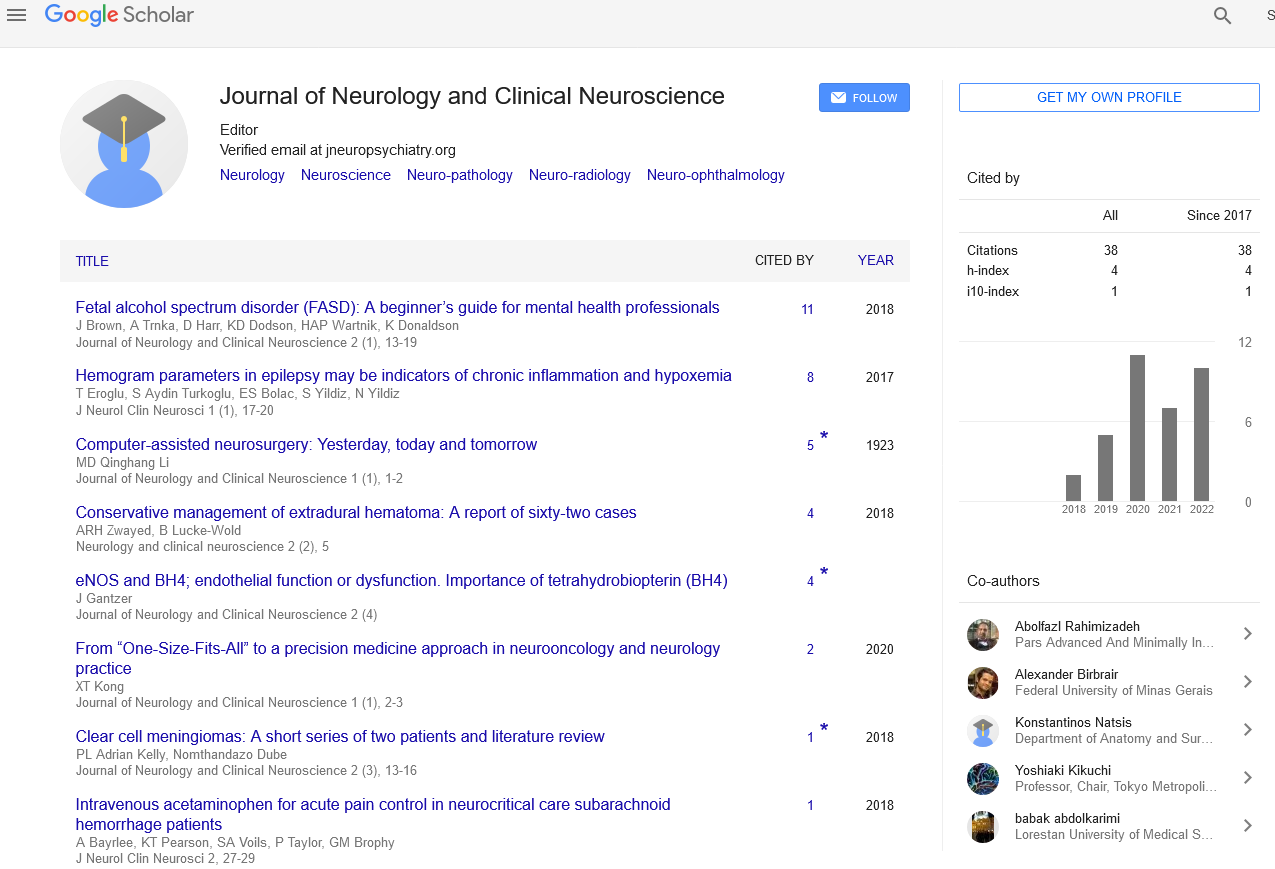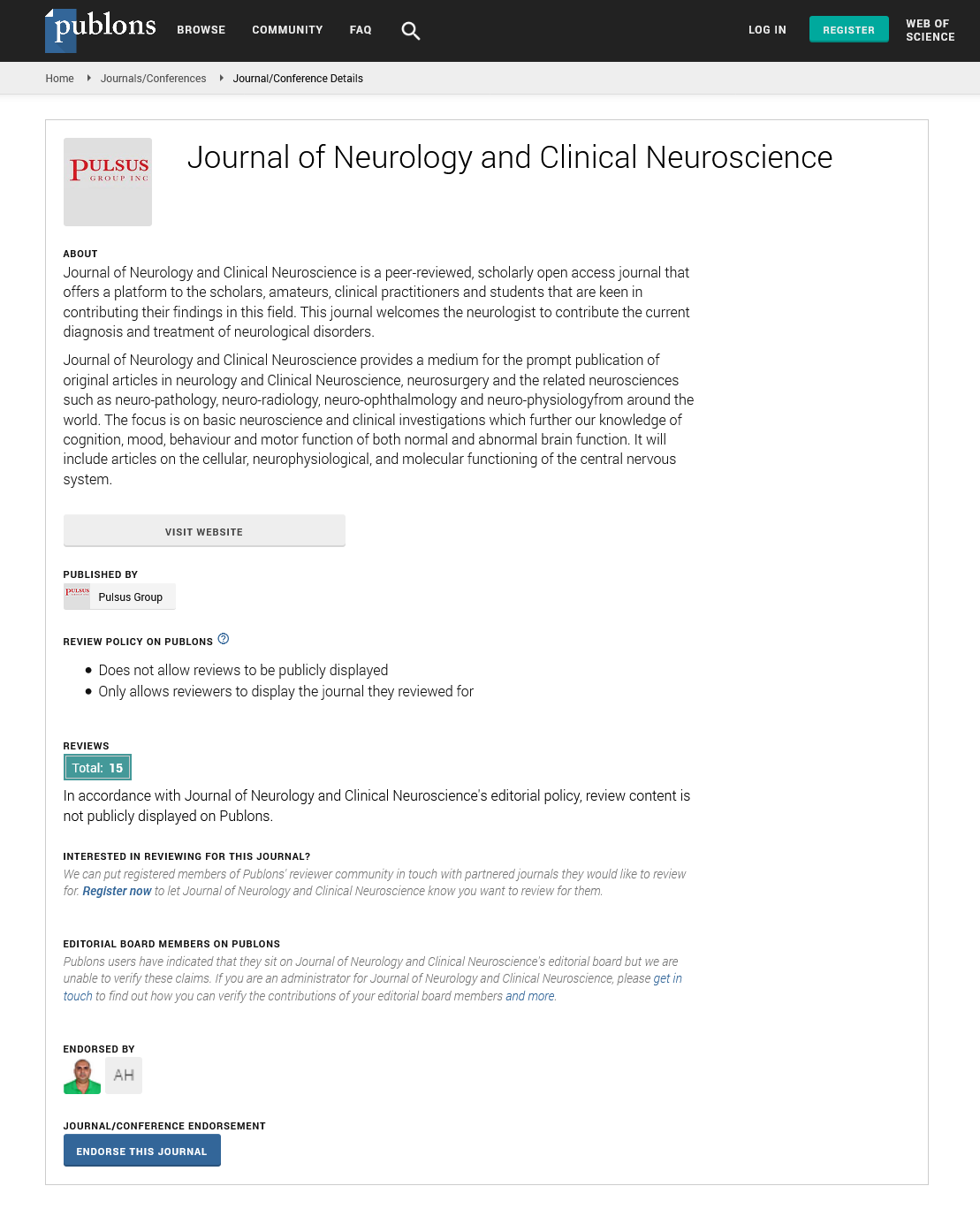Ocrelizumab for the onset of tumefactive multiple sclerosis
Received: 30-Nov-2022, Manuscript No. PULJNCN-22-5802; Editor assigned: 02-Dec-2022, Pre QC No. PULJNCN-22-5802 (PQ); Reviewed: 16-Dec-2022 QC No. PULJNCN-22-5802; Revised: 17-Jan-2023, Manuscript No. PULJNCN-22-5802 (R); Published: 24-Jan-2023
Citation: Ellis C. Ocrelizumab for the onset of tumefactive multiple sclerosis. J Neurol Clin Neurosci 2023;7(1):1-2.
This open-access article is distributed under the terms of the Creative Commons Attribution Non-Commercial License (CC BY-NC) (http://creativecommons.org/licenses/by-nc/4.0/), which permits reuse, distribution and reproduction of the article, provided that the original work is properly cited and the reuse is restricted to noncommercial purposes. For commercial reuse, contact reprints@pulsus.com
Abstract
The course of Multiple Sclerosis (MS) is incredibly diverse. "Aggressive" disease is characterised by a relapsing history that rapidly worsens physical and cognitive dysfunction, frequently in spite of treatment. Presentation of the case: There is a lack of standardisation in the diagnostic and management of aggressive Multiple Sclerosis (MS). There are currently no definite reports of ocrelizumab being used to treat tumefactive, breakthrough diseases. A 34 years old Caucasian lady was hospitalised after experiencing nausea, vomiting, and slight gait ataxia. Multiple demyelinating lesions in the brain were identified using Magnetic Resonance Imaging (MRI), many of which were infratentorial and displayed tumefactive appearance and gadolinium enhancement.
Keywords
Multiple sclerosis; Magnetic Resonance Imaging (MRI); Cognitive dysfunction; Tumefactive appearance; Relapsing history
Introduction
Between patients and over time within the same patient, the clinical course of Multiple Sclerosis (MS) exhibits remarkable heterogeneity. Relapsing disease is referred to as "aggressive," "very active," or "malignant" disease when it progresses rapidly and causes physical and cognitive damage, frequently in spite of treatment. Depending on the classification employed, this kind of MS is not prevalent and could be seen in 4%–14% of MS patients. The following clinical and imaging characteristics have been linked to an aggressive illness course, possibly in conjunction with high CSF and/or serum neurofilament levels: Older age or motor symptoms at onset; slow recovery from initial attacks; high relapse frequency or pyramidal signs during early follow up; high lesion load on T2 weighted images; location of spinal and infratentorial lesions; or presence of more than two enhancing lesions during the first years of disease atypical MSs with an aggressive course are frequently mentioned by authors, too, including Balo's concentric sclerosis, Marburg variant, Schilder's disease, and tumefactive MS.
Description
The following clinical and imaging characteristics have been linked to an aggressive illness course, possibly in conjunction with high CSF and/or serum neurofilament levels: Older age or motor symptoms at onset; slow recovery from initial attacks; high relapse frequency or pyramidal signs during early follow up; high lesion load on T2 weighted images; location of spinal and infratentorial lesions; or presence of more than two enhancing lesions during the first years of disease atypical MSs with an aggressive course are frequently mentioned by authors, too, including Balo's concentric sclerosis, Marburg variant, Schilder's disease, and tumefactive MS. Early detection of patients with aggressive onset or who are becoming aggressive despite therapy (i.e., breakthrough disease) is primarily reliant on clinical judgement for both conventional MS and its variations. Furthermore, there is no agreement on.
The FDA approved DMTs for very active MS include alemtuzumab, cladribine, mitoxantrone, natalizumab, and fingolimod. Induction therapy protocols frequently include ocrelizumab, rituximab, autologous Haematopoietic Stem Cell Transplantation (aHSCT), and cyclophosphamide. There is absence tumefactive MS therapy information found in the literature: Rituximab has been studied in some cases, and cyclophosphamide has demonstrated therapeutic effects, but it’s off label use and the absence of phase 3 randomised clinical trials may restrict its utilisation. Additionally, there have been incidences of drug induced tumorigenesis (particularly with fingolimod and natalizumab). We are not aware of any reports of ocrelizumab being used for breakthrough tumefactive illness. While a spinal cord MRI was negative, a vascular abnormality involving the right internal carotid artery was discovered. The pressure, appearance, total cell count, glucose, and protein levels of the Cerebrospinal Fluid (CSF) were all within acceptable limits. While several rheumatologic, viral, and autoimmune disorders were ruled out by biochemical tests, including anti-AQP4 and anti-MOG antibodies in cell based assay, the CSF analysis showed the existence of oligoclonal bands. Somatosensory and motor evoked potentials were normal, while brainstem auditory and visual ones displayed bilaterally altered responses. Her clinical symptoms deteriorated despite receiving treatment with Intravenous Methylprednisolone (IVMP) 1000 mg every day for 5 days after being diagnosed with severe MS. Impairment of extraocular movement, vertical nystagmus, left facial palsy. After seven days of treatment with another IVMP cycle, she received ocrelizumab (two 300 mg infusions 14 days apart). She began to feel better after receiving this treatment, and upon being released, a neurological test indicated face parenthesis, right hypoacusia, horizontal nystagmus, a small loss of vibration sensitivity in all four limbs, modest gait abnormalities, and left limb ataxia (EDSS 3.0). Her clinical conditions continued to improve (EDSS 1.5 for mild weakness on the right limbs at 12 months), and two subsequent MRIs revealed no new lesions and a reduction in size of the pre existing ones, with complete resolution of contrast enhancement. She underwent ocrelizumab treatment during a 12- month follow up and achieved a complete depletion of CD19+ B cells. Acute MS patients with tumefactive demyelination exhibit massive tumor like lesions that are frequently accompanied by inadequate ring enhancement and infrequently encircled by edoema. Despite the fact that not all patients respond to steroids, steroids can reduce lesion size and treat clinical illness.
Conclusion
The existence of oligoclonal bands, steroid resistance, and radiological findings in our patient suggested the possibility of other demyelinating conditions, such as Acute Disseminated Encephalomyelitis (ADEM) or Myelin Oligodendrocyte Glycoprotein Antibody Associated Disease (MOGAD). In spite of the lack of clear standards, some authors have proposed treating the acute phase of tumefactive MS with a high dosage of IVMP, followed by plasmapheresis, and potentially rituximab (1000 mg/day on days 1 and 8 in case of no response). Rituximab proved effective in some cases of fulminant onset cancer that did not respond to corticosteroids and plasmapheresis. Due to their combined toxicity, cyclophosphamide and mitoxantrone have a restricted number of applications. Due to our patient's vascular malformation, alemtuzumab was avoided because it was linked to major side effects such cardiovascular instability, stroke, and infusion related arterial dissections. Due to its safety concerns, has mostly been utilised in an escalation therapy method when more than one first or second line Disease Modifying Therapies (DMTs) have failed. As long as their usage is sustained, fingolimod and natalizumab "freeze" the inflammatory process; consequently, their withdrawal is linked to a prominent rebound disease activity, which can be avoided by switching to another DMT within a 3 to 6 months period.





